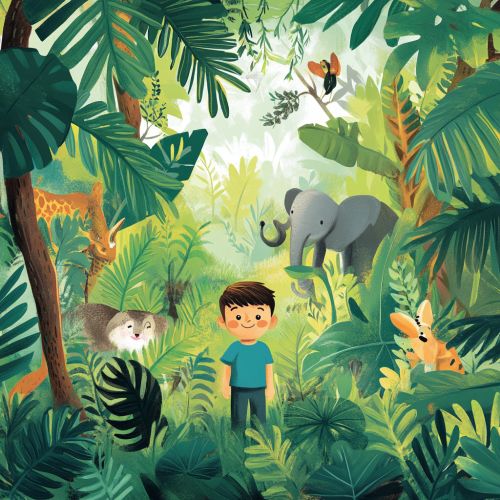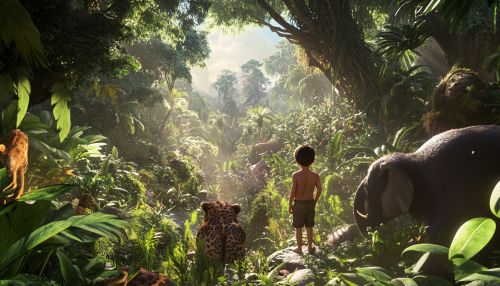Mowgli
Introduction
Mowgli is a fictional character and the protagonist of Rudyard Kipling's "The Jungle Book" stories, which were first published in 1894. These stories are set in the jungles of India and revolve around the adventures of Mowgli, a human child who is raised by wolves. The character of Mowgli has become iconic in literature and popular culture, representing themes of nature versus nurture, the struggle for identity, and the conflict between civilization and the wild.
Character Origins and Development
The character of Mowgli was introduced in Kipling's "The Jungle Book" and its sequel, "The Second Jungle Book" (1895). Kipling, who was born in British India, drew inspiration from Indian wildlife, culture, and the colonial experience. Mowgli's name is derived from the Hindi word "मोगली" (Mowgli), which means "frog," a nickname given to him by his wolf family due to his lack of fur and his ability to swim.
Mowgli's story begins when he is found as an infant in the jungle by the wolf pack led by Akela. He is adopted by the wolves and grows up learning the ways of the jungle, guided by his mentors, Baloo the bear and Bagheera the black panther. Throughout the stories, Mowgli faces various challenges, including the threat of the tiger Shere Khan, who seeks to kill him.
Themes and Symbolism
Mowgli's journey is rich with themes and symbolism. One of the central themes is the idea of nature versus nurture, as Mowgli is a human child raised in the wild. His character explores the balance between his innate human traits and the animal instincts he acquires from his upbringing. This theme is further highlighted by his interactions with both the animal and human worlds.
Another significant theme is the struggle for identity. Mowgli's dual existence between the jungle and human society forces him to confront questions about who he is and where he belongs. This internal conflict is mirrored by the external conflict between the jungle and the encroaching human civilization, symbolizing the broader tension between natural and human-made environments.
Cultural Impact and Adaptations
Mowgli's character has been adapted into various media, including films, television series, and stage productions. One of the most famous adaptations is Disney's animated film "The Jungle Book" (1967), which introduced Mowgli to a global audience. This adaptation, while taking creative liberties, retained the core elements of Mowgli's story and contributed to the character's enduring popularity.
In addition to Disney's version, there have been numerous other adaptations, including live-action films and television series. Each adaptation offers a unique interpretation of Mowgli's character and the themes of Kipling's original stories. These adaptations often reflect the cultural and social contexts of their time, demonstrating the character's versatility and relevance.
Literary Analysis
Kipling's portrayal of Mowgli is complex and multifaceted. The character serves as a vehicle for exploring colonial and post-colonial themes, particularly the relationship between the colonizer and the colonized. Mowgli's ability to navigate both the jungle and human worlds can be seen as a metaphor for the hybrid identity of individuals in colonial contexts.
Furthermore, Mowgli's interactions with the animal characters in the stories provide insight into Kipling's views on leadership, loyalty, and morality. Characters like Baloo and Bagheera serve as moral guides for Mowgli, teaching him the "Law of the Jungle," which emphasizes respect, responsibility, and balance within the natural world.
Psychological Perspectives
From a psychological perspective, Mowgli's character can be analyzed through the lens of developmental psychology. His upbringing in the jungle presents a unique case study of human development in an unconventional environment. The absence of human socialization raises questions about the role of environment in shaping personality and behavior.
Mowgli's experiences also touch on the concept of attachment theory, as his bonds with the wolf pack and his mentors provide a substitute for traditional parental relationships. These attachments influence his emotional and social development, highlighting the importance of nurturing relationships in childhood.
Conclusion
Mowgli remains a compelling and enduring character in literature and popular culture. His story continues to captivate audiences with its exploration of identity, belonging, and the interplay between nature and civilization. Through various adaptations and interpretations, Mowgli's character has transcended its original context, becoming a symbol of the universal human experience.


